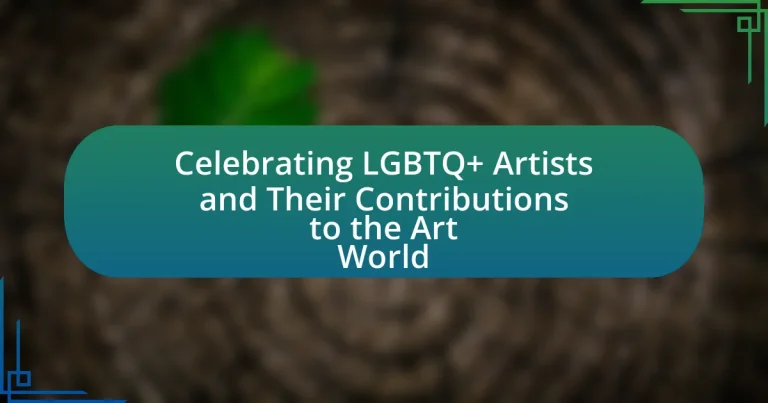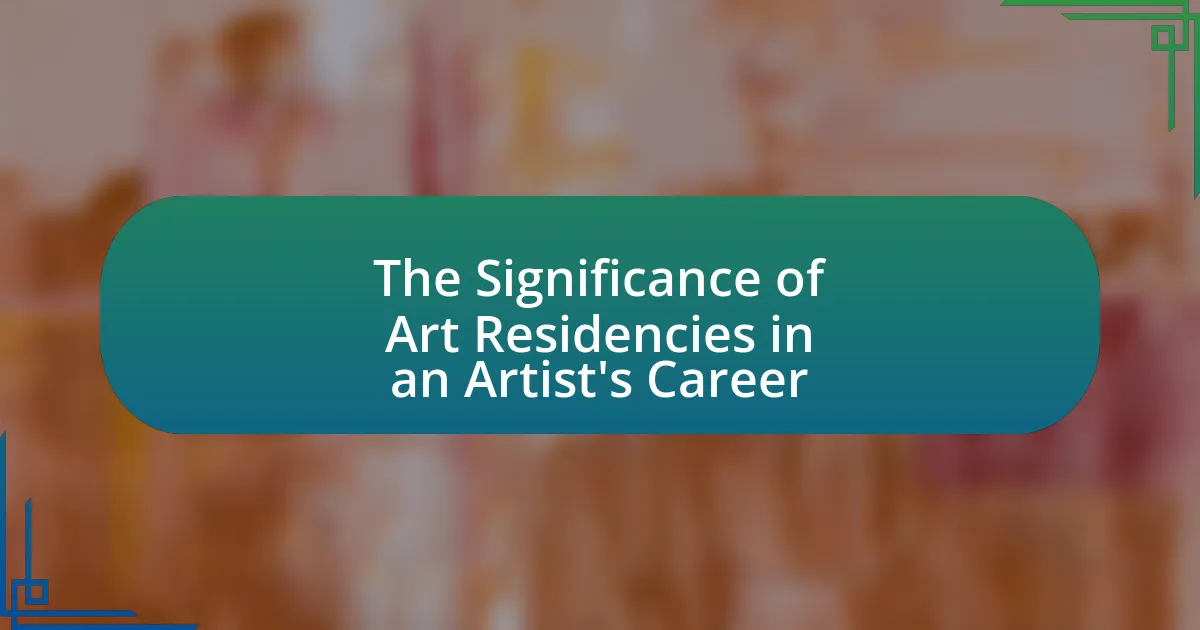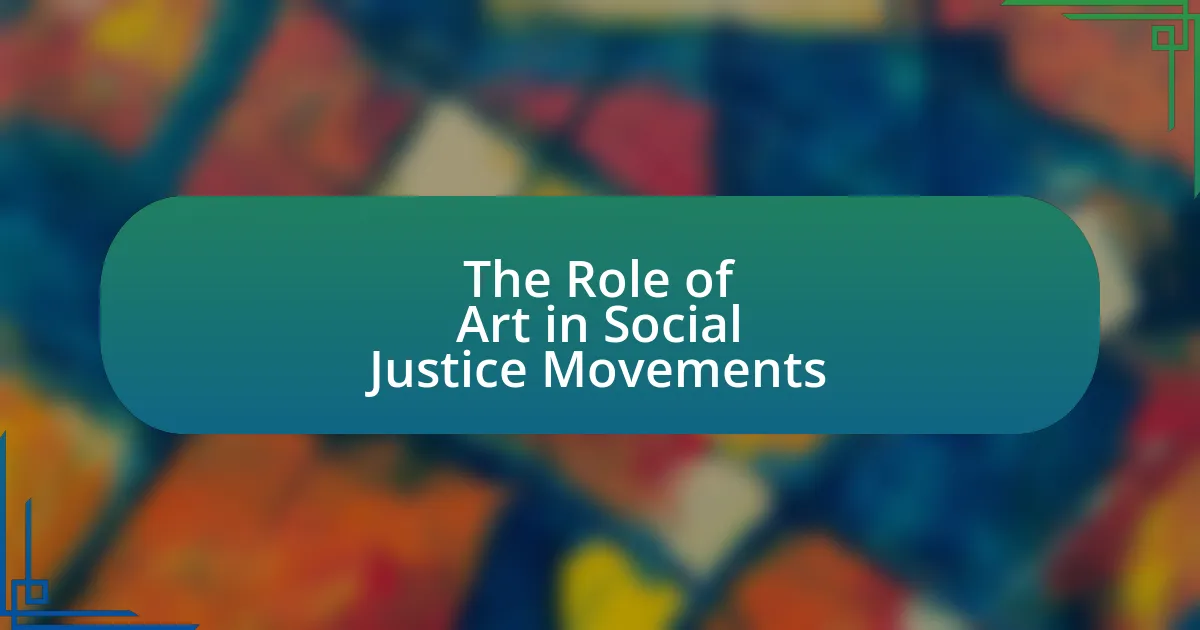The article focuses on the significant contributions of LGBTQ+ artists to the art world, highlighting their diverse perspectives and the ways they challenge societal norms. It discusses the emergence of movements such as Queer Art, the influence of notable artists like Keith Haring, Frida Kahlo, and Andy Warhol, and the impact of LGBTQ+ themes in contemporary art. The article also examines the importance of celebrating LGBTQ+ artists for fostering inclusivity, the role of social media in enhancing their visibility, and the various platforms and initiatives that support their work. Additionally, it addresses the challenges faced by LGBTQ+ artists and the legacies they leave in the art community.

What are the contributions of LGBTQ+ artists to the art world?
LGBTQ+ artists have significantly contributed to the art world by introducing diverse perspectives, challenging societal norms, and enriching cultural dialogues. Notable contributions include the emergence of movements such as Queer Art, which explores themes of identity, sexuality, and social justice, exemplified by artists like Keith Haring and David Hockney. Furthermore, LGBTQ+ artists have played a crucial role in the visibility of marginalized communities, as seen in the works of artists like Frida Kahlo and Andy Warhol, who addressed issues of gender and sexuality in their art. The impact of LGBTQ+ artists is also evident in the establishment of spaces like the Leslie-Lohman Museum of Gay and Lesbian Art in New York, which showcases LGBTQ+ art and history, reinforcing their essential role in the broader narrative of art history.
How have LGBTQ+ artists influenced various art movements?
LGBTQ+ artists have significantly influenced various art movements by introducing themes of identity, sexuality, and social justice into their work. For example, during the 20th century, artists like Andy Warhol and Keith Haring brought queer culture into the mainstream through pop art and street art, respectively, challenging societal norms and perceptions. Their contributions not only shaped the visual language of movements such as Pop Art and Graffiti Art but also fostered greater visibility and acceptance of LGBTQ+ issues within the broader art community. Additionally, the Stonewall Riots of 1969 catalyzed a wave of activism in art, leading to the emergence of movements like Queer Art, which directly addressed the struggles and experiences of LGBTQ+ individuals. This intersection of art and activism has been pivotal in shaping contemporary art discourse, making LGBTQ+ artists essential figures in the evolution of modern art movements.
What specific styles or techniques have been popularized by LGBTQ+ artists?
LGBTQ+ artists have popularized styles and techniques such as queer abstraction, which challenges traditional representations of identity and sexuality through non-representational forms. This movement is exemplified by artists like David Hockney, whose vibrant color palettes and innovative compositions have redefined landscape painting, and Keith Haring, whose graffiti-inspired works incorporate social commentary on LGBTQ+ issues. Additionally, the use of performance art as a medium for exploring gender and identity has been significantly advanced by artists like Marina Abramović and Ron Athey, who utilize their bodies to confront societal norms. These styles and techniques reflect the diverse experiences and perspectives within the LGBTQ+ community, contributing to a broader understanding of art and identity.
How do LGBTQ+ themes manifest in the works of these artists?
LGBTQ+ themes manifest in the works of these artists through the exploration of identity, representation, and social issues. Artists often depict personal narratives that reflect their experiences with sexuality and gender, using symbolism and visual language to challenge societal norms. For instance, Keith Haring’s vibrant street art addresses themes of love, acceptance, and the AIDS crisis, while Frida Kahlo’s self-portraits explore her bisexuality and complex identity. Additionally, contemporary artists like Zanele Muholi use photography to document and celebrate Black LGBTQ+ lives, emphasizing visibility and empowerment. These artistic expressions not only resonate with LGBTQ+ communities but also foster broader conversations about diversity and inclusion in society.
Why is it important to celebrate LGBTQ+ artists?
Celebrating LGBTQ+ artists is important because it acknowledges their unique contributions to culture and society, fostering inclusivity and representation in the arts. LGBTQ+ artists often bring diverse perspectives and experiences that challenge societal norms, enriching the artistic landscape. For instance, studies show that representation in the arts can lead to greater acceptance and understanding of LGBTQ+ issues, as seen in the increased visibility of LGBTQ+ themes in mainstream media and art exhibitions. Celebrating these artists not only honors their work but also promotes a more equitable and diverse cultural narrative.
What impact does recognition have on LGBTQ+ artists’ careers?
Recognition significantly enhances LGBTQ+ artists’ careers by increasing visibility and access to opportunities. When LGBTQ+ artists receive recognition, they often gain a broader audience, which can lead to increased sales, exhibition opportunities, and collaborations. For instance, studies have shown that artists who are acknowledged in major art events or receive awards experience a notable boost in their market value and public interest. Additionally, recognition can foster a sense of community and validation, encouraging more LGBTQ+ individuals to pursue careers in the arts, thereby enriching the cultural landscape.
How does celebrating LGBTQ+ artists contribute to broader societal acceptance?
Celebrating LGBTQ+ artists contributes to broader societal acceptance by fostering visibility and representation of diverse identities within the cultural landscape. This visibility challenges stereotypes and promotes understanding, as art often serves as a reflection of society. For instance, studies have shown that increased representation of LGBTQ+ individuals in media and the arts correlates with greater acceptance and support for LGBTQ+ rights among the general population. A report by the American Psychological Association indicates that exposure to positive portrayals of LGBTQ+ individuals can reduce prejudice and increase empathy. Thus, the celebration of LGBTQ+ artists not only enriches the art world but also plays a crucial role in advancing societal acceptance and equality.

Who are some notable LGBTQ+ artists throughout history?
Notable LGBTQ+ artists throughout history include Leonardo da Vinci, Frida Kahlo, Andy Warhol, and Keith Haring. Leonardo da Vinci, a Renaissance polymath, is often speculated to have had same-sex relationships, influencing art and science. Frida Kahlo, a Mexican painter known for her self-portraits, openly embraced her bisexuality and explored themes of identity and gender. Andy Warhol, a leading figure in the pop art movement, was openly gay and used his art to challenge societal norms. Keith Haring, an activist and artist, used his work to address issues of AIDS and LGBTQ+ rights, leaving a lasting impact on contemporary art. These artists not only contributed significantly to their respective fields but also shaped cultural conversations around sexuality and identity.
What are the key achievements of prominent LGBTQ+ artists?
Prominent LGBTQ+ artists have achieved significant milestones that have shaped the art world, including groundbreaking representation, influential movements, and critical acclaim. For instance, Andy Warhol revolutionized pop art and challenged societal norms through his work, while Keith Haring used his art to advocate for LGBTQ+ rights and raise awareness about HIV/AIDS. Additionally, artists like Frida Kahlo have become icons for their exploration of identity and gender, influencing countless others. These achievements are evidenced by numerous awards, exhibitions, and the lasting impact these artists have had on both contemporary art and social movements.
How did these artists overcome challenges in their careers?
LGBTQ+ artists overcame challenges in their careers through resilience, community support, and innovative expression. Many faced societal discrimination and lack of representation, which they countered by creating inclusive spaces and networks that fostered collaboration and visibility. For instance, the Stonewall Riots in 1969 galvanized LGBTQ+ artists to use their work as a form of activism, leading to the establishment of art collectives that amplified their voices. Additionally, artists like Keith Haring and Andy Warhol utilized their platforms to address social issues, thereby transforming personal struggles into powerful artistic statements that resonated widely. This combination of community solidarity and bold artistic expression has been pivotal in navigating and overcoming the obstacles they encountered.
What legacies have they left in the art world?
LGBTQ+ artists have left significant legacies in the art world by challenging societal norms and expanding the boundaries of artistic expression. Their contributions include the introduction of diverse perspectives that reflect the complexities of identity, sexuality, and culture, which have enriched contemporary art. For instance, artists like Keith Haring and Andy Warhol utilized their platforms to address social issues such as AIDS awareness and LGBTQ+ rights, influencing both art and activism. Additionally, the visibility and representation of LGBTQ+ themes in art have fostered greater acceptance and understanding within society, as seen in the increasing presence of LGBTQ+ narratives in major art institutions and exhibitions.
How have contemporary LGBTQ+ artists shaped modern art?
Contemporary LGBTQ+ artists have significantly shaped modern art by introducing diverse perspectives and challenging societal norms. Their work often explores themes of identity, sexuality, and social justice, which has broadened the scope of artistic expression. For instance, artists like Keith Haring and David Hockney have utilized their platforms to address issues such as the AIDS crisis and LGBTQ+ visibility, influencing both public perception and artistic discourse. Additionally, the rise of queer art movements has led to increased representation in galleries and museums, fostering a more inclusive art world. This shift is evidenced by the inclusion of LGBTQ+ artists in major exhibitions, such as the 2019 “Queer British Art” at Tate Britain, which highlighted the historical and contemporary contributions of LGBTQ+ individuals to the art scene.
What themes are prevalent in the works of today’s LGBTQ+ artists?
Today’s LGBTQ+ artists frequently explore themes of identity, representation, and social justice. These themes reflect the complexities of personal and collective experiences within the LGBTQ+ community. For instance, many artists address issues such as gender fluidity, intersectionality, and the impact of societal norms on individual identity. Additionally, the exploration of love, sexuality, and the fight against discrimination are prevalent, as artists use their work to advocate for equality and challenge stereotypes. This thematic focus is supported by the increasing visibility of LGBTQ+ narratives in contemporary art exhibitions and cultural discussions, highlighting the importance of these voices in shaping societal understanding and acceptance.
How do contemporary LGBTQ+ artists engage with social issues through their art?
Contemporary LGBTQ+ artists engage with social issues through their art by addressing themes such as identity, discrimination, and representation. These artists often use their work to challenge societal norms and provoke discussions about LGBTQ+ rights and experiences. For instance, artists like Keith Haring and David Hockney have utilized vibrant imagery and symbolism to comment on the AIDS crisis and the struggles faced by the LGBTQ+ community. Additionally, exhibitions such as “Queer British Art” at the Tate Britain highlight the historical and ongoing contributions of LGBTQ+ artists, showcasing how their work reflects and influences social change. This engagement not only raises awareness but also fosters a sense of community and solidarity within and beyond the LGBTQ+ spectrum.

What platforms exist for promoting LGBTQ+ artists today?
Platforms that exist for promoting LGBTQ+ artists today include social media networks like Instagram and TikTok, dedicated art platforms such as Artsy and Saatchi Art, and community-focused websites like LGBTQ+ Arts and Queer Art. These platforms provide visibility and opportunities for LGBTQ+ artists to showcase their work, connect with audiences, and engage with the broader art community. For instance, Instagram has become a vital tool for artists to share their portfolios and gain followers, while Queer Art offers resources and support specifically tailored to LGBTQ+ creatives.
How do galleries and museums support LGBTQ+ artists?
Galleries and museums support LGBTQ+ artists by providing exhibition opportunities, funding, and resources tailored to their unique experiences. These institutions often curate shows that highlight LGBTQ+ themes and histories, such as the 2019 exhibition “Queer British Art” at Tate Britain, which showcased the contributions of LGBTQ+ artists from the 1860s to the present. Additionally, many galleries and museums have established grants and fellowships specifically for LGBTQ+ artists, fostering their creative development and visibility in the art world. For instance, the Leslie-Lohman Museum of Gay and Lesbian Art in New York is dedicated to preserving and promoting LGBTQ+ art and artists, further solidifying the commitment of galleries and museums to support this community.
What initiatives are in place to showcase LGBTQ+ art?
Various initiatives exist to showcase LGBTQ+ art, including dedicated art festivals, galleries, and community programs. For instance, the Queer Arts Festival in Vancouver highlights LGBTQ+ artists through exhibitions, performances, and workshops, fostering visibility and engagement. Additionally, organizations like the Leslie-Lohman Museum of Gay and Lesbian Art in New York City focus on preserving and exhibiting LGBTQ+ art, providing a platform for both historical and contemporary works. These initiatives not only celebrate LGBTQ+ creativity but also promote awareness and understanding of LGBTQ+ issues within the broader art community.
How can art festivals and events promote LGBTQ+ artists?
Art festivals and events can promote LGBTQ+ artists by providing dedicated platforms for their work, fostering visibility and representation within the art community. These festivals often feature curated exhibitions, performances, and workshops that highlight LGBTQ+ themes and narratives, allowing artists to connect with diverse audiences. For instance, events like the Queer Arts Festival in Vancouver showcase LGBTQ+ artists, creating a space for dialogue and cultural exchange. Additionally, partnerships with LGBTQ+ organizations can enhance outreach and support for these artists, ensuring their contributions are recognized and celebrated.
What role does social media play in the visibility of LGBTQ+ artists?
Social media significantly enhances the visibility of LGBTQ+ artists by providing them with platforms to showcase their work and connect with audiences globally. Through platforms like Instagram, Twitter, and TikTok, LGBTQ+ artists can share their art, engage with fans, and build communities that support their identities and creative expressions. For instance, a study by the Pew Research Center found that 72% of LGBTQ+ individuals use social media, which allows them to amplify their voices and reach wider audiences than traditional art venues often permit. This increased visibility not only promotes individual artists but also fosters greater representation and acceptance of LGBTQ+ narratives in the broader art world.
How can LGBTQ+ artists leverage social media for their careers?
LGBTQ+ artists can leverage social media to enhance their careers by building a strong online presence, engaging with their audience, and showcasing their work. Social media platforms like Instagram, TikTok, and Twitter allow artists to share their art, connect with fans, and network with other creatives. For instance, a study by the Pew Research Center found that 69% of adults in the U.S. use social media, providing a vast audience for artists to reach. Additionally, LGBTQ+ artists can utilize hashtags related to their identity and art to increase visibility and foster community engagement, which can lead to opportunities such as collaborations, exhibitions, and sales.
What are some successful examples of LGBTQ+ artists using social media?
Successful examples of LGBTQ+ artists using social media include Lil Nas X, who gained fame through platforms like Twitter and TikTok, leveraging viral marketing and engaging content to promote his music and advocate for LGBTQ+ rights. Another example is Troye Sivan, who utilizes Instagram to connect with fans and share personal stories, enhancing visibility for LGBTQ+ issues. Additionally, artists like Hayley Kiyoko have effectively used YouTube to create a platform for LGBTQ+ representation in music videos and storytelling. These artists demonstrate the power of social media in amplifying LGBTQ+ voices and fostering community engagement.

How can we further support LGBTQ+ artists and their contributions?
To further support LGBTQ+ artists and their contributions, we can increase funding and resources specifically allocated for LGBTQ+ art initiatives. Research indicates that targeted funding can significantly enhance visibility and opportunities for marginalized artists, as seen in programs like the Queer Art Mentorship, which connects emerging LGBTQ+ artists with established professionals. Additionally, promoting LGBTQ+ art through exhibitions, grants, and public art projects can foster a more inclusive art community and ensure diverse narratives are represented.
What actions can individuals take to promote LGBTQ+ artists?
Individuals can promote LGBTQ+ artists by actively supporting their work through purchasing art, attending exhibitions, and sharing their creations on social media. By buying art from LGBTQ+ artists, individuals directly contribute to their financial stability and visibility in the art community. Attending exhibitions showcases the artists’ work to a broader audience, while sharing their creations on social media platforms amplifies their reach and recognition. According to a 2021 report by the National Endowment for the Arts, supporting diverse artists enhances cultural representation and fosters inclusivity in the arts.
How can art collectors and patrons support LGBTQ+ artists?
Art collectors and patrons can support LGBTQ+ artists by actively purchasing their work and promoting their visibility in the art market. By acquiring pieces from LGBTQ+ artists, collectors not only provide financial support but also validate the artists’ contributions to the cultural landscape. Furthermore, patrons can advocate for LGBTQ+ representation in galleries and exhibitions, ensuring that these artists receive the recognition they deserve. Research indicates that diverse representation in the arts leads to a richer cultural dialogue and fosters inclusivity, which is essential for the growth of the art community.
What are some effective ways to advocate for LGBTQ+ representation in the arts?
Effective ways to advocate for LGBTQ+ representation in the arts include promoting inclusive policies within arts organizations and supporting LGBTQ+ artists through grants and funding opportunities. Arts organizations can implement diversity initiatives that prioritize LGBTQ+ voices in programming and exhibitions, ensuring that their work is visible and celebrated. Additionally, creating partnerships with LGBTQ+ community organizations can enhance outreach and engagement, fostering a supportive environment for artists. Research shows that representation in the arts not only enriches cultural narratives but also contributes to societal acceptance, as seen in studies by the Williams Institute, which highlight the positive impact of visibility on LGBTQ+ communities.
What resources are available for aspiring LGBTQ+ artists?
Aspiring LGBTQ+ artists can access various resources designed to support their artistic development and visibility. Organizations such as the Queer Arts Festival and the LGBTQ+ Artists Network provide platforms for showcasing work, networking opportunities, and mentorship programs. Additionally, grants and funding opportunities specifically for LGBTQ+ artists, like the Astraea Lesbian Foundation for Justice, offer financial support to help realize artistic projects. Art schools and workshops often have LGBTQ+ specific programs, fostering inclusive environments for learning and collaboration. These resources collectively enhance the artistic landscape for LGBTQ+ individuals, promoting diversity and representation in the art world.
How can mentorship programs benefit LGBTQ+ artists?
Mentorship programs can significantly benefit LGBTQ+ artists by providing them with guidance, support, and networking opportunities that are often lacking in traditional art spaces. These programs foster a sense of community and belonging, which is crucial for artists who may face discrimination or isolation due to their sexual orientation or gender identity. Research indicates that mentorship can enhance artistic development and career advancement; for instance, a study by the National Endowment for the Arts found that artists with mentors are more likely to achieve professional success and recognition. Additionally, mentorship programs can help LGBTQ+ artists navigate the complexities of the art world, including funding opportunities and exhibition spaces, ultimately leading to greater visibility and representation in the arts.
What grants and funding opportunities exist for LGBTQ+ artists?
Grants and funding opportunities for LGBTQ+ artists include the Queer|Art|Mentorship program, which pairs emerging LGBTQ+ artists with established mentors, and the Astraea Lesbian Foundation for Justice, which provides grants to LGBTQ+ artists and organizations. Additionally, the National Endowment for the Arts offers funding that can be accessed by LGBTQ+ artists through various grant programs. The importance of these funding opportunities is underscored by the fact that they help foster creativity and visibility within the LGBTQ+ community, supporting diverse artistic expressions and projects.




